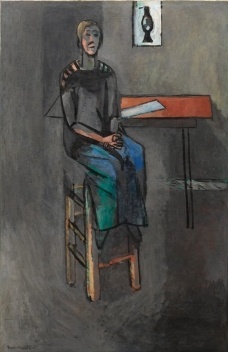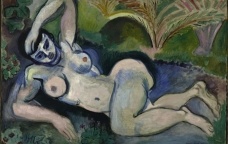
newspaper
agenda cultural
The exhibition explores a pivotal point in Henri Matisse’s career, when he developed his most demanding, experimental, and enigmatic works
It is the first exhibition devoted to the work of this important period in Matisse’s career, and thoroughly explores his working processes and the revolutionary experimentation of what he called his ?methods of modern construction.? Organized by The Museum of Modern Art and The Art Institute of Chicago, the exhibition is curated by John Elderfield, Chief Curator Emeritus of Painting and Sculpture at The Museum of Modern Art, and Stephanie D’Alessandro, Gary C. and Frances Comer Curator of Modern Art at The Art Institute of Chicago. It is currently on view at the Art Institute through June 20, 2010.
Matisse: Radical Invention, 1913–1917 examines Matisse’s production from his return to Paris from Morocco in 1913 to his departure for Nice in 1917, which comprises a major turning point in the artist’s career. Over these five years, he developed his most demanding, experimental, and enigmatic works: paintings that are abstracted and rigorously purged of descriptive detail, geometric and sharply composed, and dominated by blacks and grays. Previously considered mainly as responses to Cubism or World War I, works from this period are reassessed and presented in this exhibition as the products of one of the most significant chapters in Matisse’s evolution as an artist.
A highlight of the exhibition is the Art Institute’s monumental painting Bathers by a River (1909–10, 1913, 1916–17), which has been the subject of extensive art-historical, archival, and scientific research into Matisse’s working methods. A painting that Matisse worked on repeatedly over a period of many years, Bathers by a River provides the key to the development of the artist’s revolutionary style during this time. Over the course of four years, Art Institute curators and conservators wedded new archival information and new imaging technologies to uncover the history of this painting’s evolution and its surprising connections with other works, most significantly MoMA’s The Moroccans (1915–16) and The Piano Lesson (1916). MoMA has likewise engaged in an investigation of works in its collection, and, through this partnership, discovered new information about Matisse’s working methods, notably the extended processes of revision in composition, color, and form in the creation of these highly ambitious paintings.
Building on this research, the exhibition showcases a wide range of Matisse’s paintings, sculptures, drawings, and prints primarily from 1913 to 1917, along with a prelude of important compositions on the Bathers theme, including the famous Blue Nude (1907) and Bathers with a Turtle (1908). Also included in the exhibition are such celebrated 1914 paintings as Interior with Goldfish, Portrait of Yvonne Landsberg, and the highly abstracted French Window at Collioure and View of Notre Dame. Also represented are the artist’s sculptures Back I, II, III, IV, and his innovative etchings, engravings, and monotypes. This latter method of printmaking was employed by Matisse only during the 1913–17 period. The exhibition also includes a special presentation of Matisse’s little-known prints dedicated to the Civil Prisoners of Bohain-en-Vermandois, a group of works the artist sold to the collector Jacques Doucet in order to provide aid for those in his northern France hometown caught behind enemy lines during World War I.
Matisse: Radical Invention, 1913–1917 is supplemented by graphic didactic materials and texts as well as visual presentations of the conservation research involved in the project. It promises to redefine our perception of this modern master and his art.

Woman on a High Stool. Paris, quai Saint-Michel, early 1914 Oil on canvas, 57 7/8 x 37 5/8" (147 x 95.5 cm) The Museum of Modern Art, New York. Gift and bequest of Florene M. Schoenborn and Samuel A. Marx, 1964 © 2010 Succession H. Matisse, Paris / Artist

Blue Nude (Memory of Biskra), 1907. Oil on canvas. 92.1 x 140.4 cm (36 1/4 x 55 1/4 in.) The Baltimore Museum of Art, The Cone Collection. © 2010 Succession H. Matisse / Artists Rights Society (ARS), New York.

